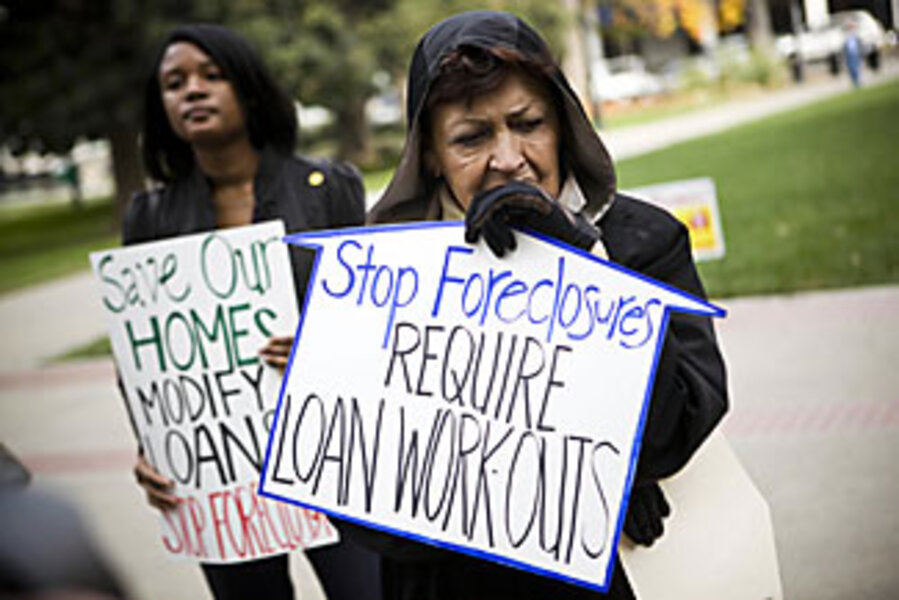Uncertain impact of US push to cut mortgage rates
Another week, another proposal to shore up plummeting US home values. This time, the US Treasury Department is considering a plan to dramatically push down mortgage rates, which it hopes will stimulate demand for new homes.
But the still embryonic plan is focused on the most creditworthy home buyers and offers little direct assistance to people struggling with debt and foreclosures on existing homes. Coming a month before President-elect Obama's inauguration and amid criticism by Democrats in Congress that emergency steps taken so far have neglected the Americans who need help most, it's likely to change in the new year.
As it stands now, according to bankers and analysts, the plan revolves around a massive new issue of government debt that would be used to buy mortgage-backed securities from Fannie Mae and Freddie Mac, the troubled mortgage-finance companies the government took control of in a September bailout worth up to $200 billion. The two firms would make this new cash available to home lenders – but on the condition they issue mortgages at 4.5 percent, down from a current average of about 5.5 percent.
That difference amounts to $300 a month on a $500,000 mortgage, making it easier to buy homes and, in theory, buoy prices by creating more demand. But a key assumption behind the proposal is that housing prices are falling because of the current financial crisis. But some analysts say it's the other way around: the current financial crisis represents a housing bubble that's been popped.
If that's true, then the prospects of government action halting the slide in home prices look dim.
"I don't share the view that houses are undervalued now and it's only the credit crisis that's keeping property prices low," says Guy Cecala, publisher of Inside Mortgage Finance, an industry newsletter. "Housing prices went up 20 percent a year in some markets for five years. These houses simply aren't worth what they were. We're not going to be able to bribe people to buy homes for more than they're worth with cheaper rates."
Mr. Cecala isn't entirely opposed to the Treasury's idea, as it would pump more money into the economy and do some good on that basis. But he and others point out that current mortgage rates are already at historically low levels and haven't helped home prices yet – in large part because too many homes were built during the construction boom of recent years. "Demand has to meet supply," he adds.
Home prices probably need to fall further before the market stabilizes, says Jack McCabe, CEO of McCabe Research, a consultant to the housing and finance industries. "If banks aren't willing to lend because housing prices are in a free fall, it doesn't matter if rates go down to 2 percent," he says. "The problem is finding a bottom for this housing market and keeping people in their homes. Trying to simply prop up prices probably won't work."
Mr. McCabe, one of the analysts who predicted the housing collapse, points out that, historically, average US home prices have been about three to four times median household incomes. But during the recent boom, particularly in high-growth areas like Arizona and Florida, prices rose in many cases to eight times households' income. "If you're looking for a bottom, that's where you'll find it."
He says the current proposal is reflective of the overall approach of the Bush administration, which he expects will contrast sharply with Mr. Obama's. "The difference is they're trying to work from the top down instead of the bottom up. They've been leaving it up to the bankers who created the mess to fix it. But how do you fix if you didn't understand the problem to begin with?"
McCabe says a more profitable approach would be to focus on keeping existing homeowners out of foreclosure, using government programs to help borrowers reduce the principal and/or interest rate on their existing loans and perhaps guarantee new mortgages.
"If money was injected specifically into the banking system to write down principal on mortgages that would have a lot more impact than bringing down already low interest rates," he says.
Indeed, the effort to help the least creditworthy borrowers got a big push from Fed Chairman Ben Bernanke Thursday.
"The foreclosure rate remains too high … more needs to be done," he said at a news conference. He specifically mentioned greater efforts to reduce the principal owed on existing homes, something the government has been reluctant to support so far, fearing it will encourage people who might be able to make payments to default – since that might make them eligible for a better deal.
Action is needed, he said, because foreclosures are on track to reach 2.25 million this year, more than double the average annual level.
He outlined a number of what he called "promising options" to reduce preventable foreclosures.
One option would ease the terms of a loan-modification plan put forward by the Federal Deposit Insurance Corp. that seeks to make monthly mortgage payments more affordable. The FDIC put this plan into effect at IndyMac Bank, a large savings and loan that failed earlier this year, and has used it to modify mortgages at other financial institutions.
Under the so-called IndyMac plan, struggling home borrowers pay interest rates of about 3 percent for five years. Rates are reduced so that borrowers aren't paying more than 38 percent of their pretax income on housing. Mr. Bernanke suggested this threshold could be lowered to perhaps 31 percent of income, with the government sharing some of the cost.
Yet another option would have the government purchase delinquent or at-risk mortgages in bulk and then refinance them into the "Hope for Homeowners" or another government program that insures home mortgages.
•Material from the Associated Press was used in this report.





